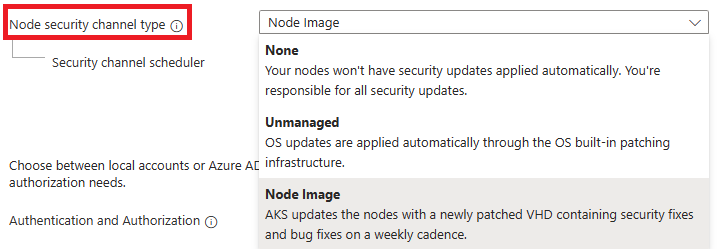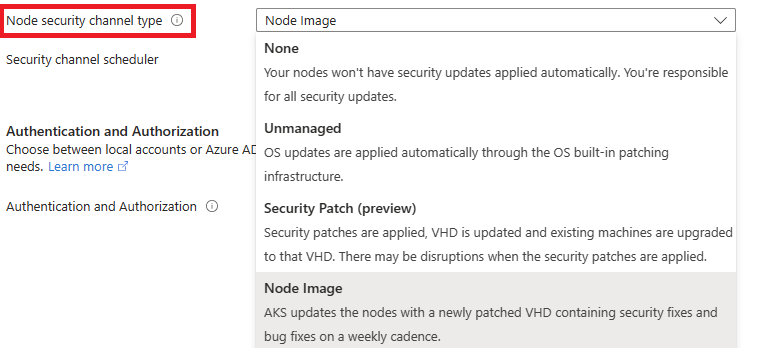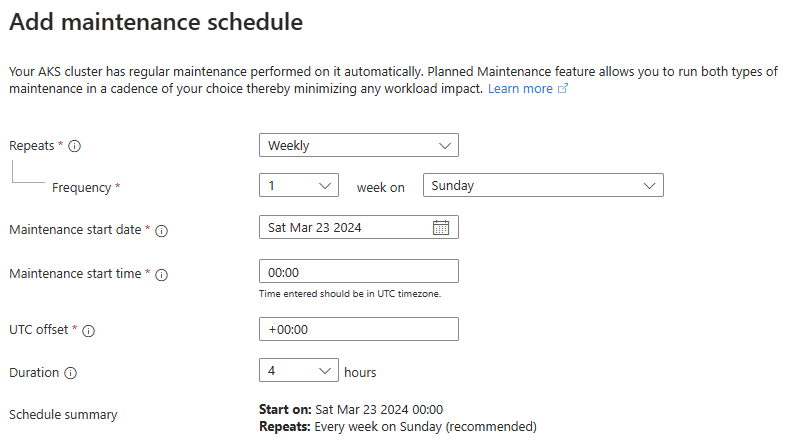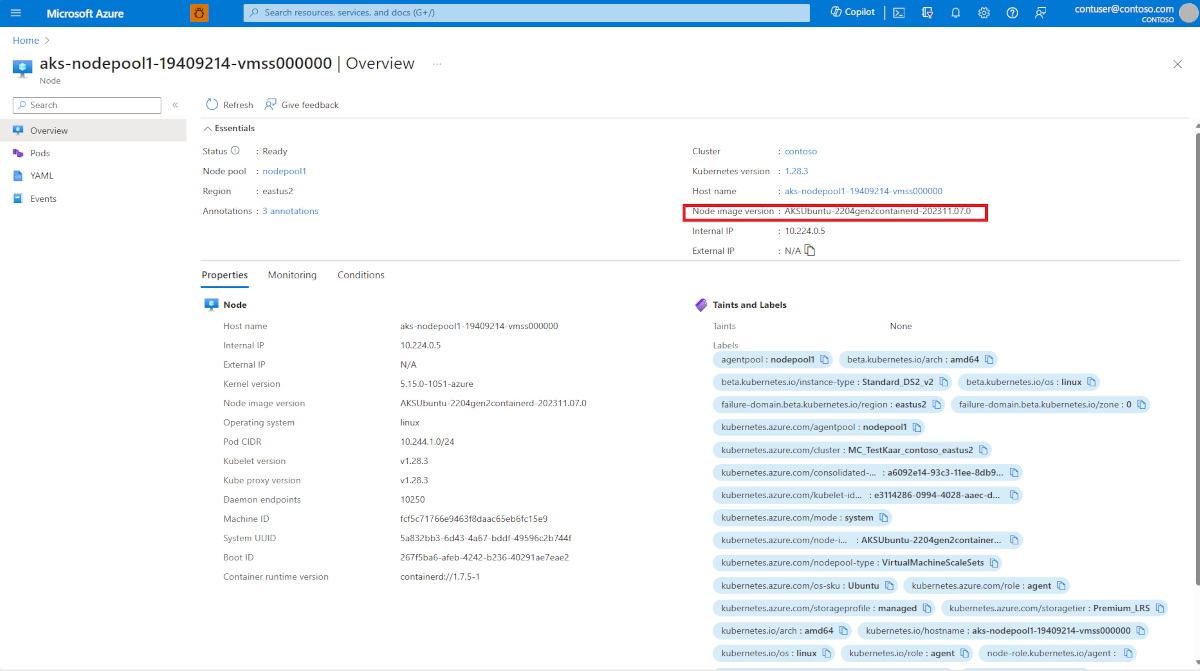Auto-upgrade node OS images
AKS provides multiple auto-upgrade channels dedicated to timely node-level OS security updates. This channel is different from cluster-level Kubernetes version upgrades and supersedes it.
Interactions between node OS auto-upgrade and cluster auto-upgrade
Node-level OS security updates are released at a faster rate than Kubernetes patch or minor version updates. The node OS auto-upgrade channel grants you flexibility and enables a customized strategy for node-level OS security updates. Then, you can choose a separate plan for cluster-level Kubernetes version auto-upgrades.
It's best to use both cluster-level auto-upgrades and the node OS auto-upgrade channel together. Scheduling can be fine-tuned by applying two separate sets of maintenance windows - aksManagedAutoUpgradeSchedule for the cluster auto-upgrade channel and aksManagedNodeOSUpgradeSchedule for the node OS auto-upgrade channel.
Channels for node OS image upgrades
The selected channel determines the timing of upgrades. When making changes to node OS auto-upgrade channels, allow up to 24 hours for the changes to take effect. Once you change from one channel to another channel, a reimage is triggered leading to rolling nodes.
Note
Node OS image auto-upgrade won't affect the cluster's Kubernetes version. Starting with API version 2023-06-01, the default for any new cluster created is NodeImage.
The following upgrade channels are available. You're allowed to choose one of these options:
| Channel | Description | OS-specific behavior |
|---|---|---|
None |
Your nodes don't have security updates applied automatically. This means you're solely responsible for your security updates. | N/A |
Unmanaged |
OS updates are applied automatically through the OS built-in patching infrastructure. Newly allocated machines are unpatched initially. The OS's infrastructure patches them at some point. | Ubuntu and Azure Linux (CPU node pools) apply security patches through unattended upgrade/dnf-automatic roughly once per day around 06:00 UTC. Windows doesn't automatically apply security patches, so this option behaves equivalently to None. You need to manage the reboot process by using a tool like kured. |
SecurityPatch |
OS security patches, which are AKS-tested, fully managed, and applied with safe deployment practices. AKS regularly updates the node's virtual hard disk (VHD) with patches from the image maintainer labeled "security only." There might be disruptions when the security patches are applied to the nodes. However AKS is limiting disruptions by only reimaging your nodes only when necessary, such as for certain kernel security packages. When the patches are applied, the VHD is updated and existing machines are upgraded to that VHD, honoring maintenance windows and surge settings. If AKS decides that reimaging nodes isn't necessary, it patches nodes live without draining pods and performs no VHD update. This option incurs the extra cost of hosting the VHDs in your node resource group. If you use this channel, Linux unattended upgrades are disabled by default. | Azure Linux doesn't support this channel on GPU-enabled VMs. SecurityPatch works on kubernetes patch versions that are deprecated, so long as the minor Kubernetes version is still supported. |
NodeImage |
AKS updates the nodes with a newly patched VHD containing security fixes and bug fixes on a weekly cadence. The update to the new VHD is disruptive, following maintenance windows and surge settings. No extra VHD cost is incurred when choosing this option. If you use this channel, Linux unattended upgrades are disabled by default. Node image upgrades support patch versions that are deprecated, so long as the minor Kubernetes version is still supported. Node images are AKS-tested, fully managed, and applied with safe deployment practices |
Set the node OS auto-upgrade channel on a new cluster
Set the node OS auto-upgrade channel on a new cluster using the
az aks createcommand with the--node-os-upgrade-channelparameter. The following example sets the node OS auto-upgrade channel toSecurityPatch.az aks create \ --resource-group myResourceGroup \ --name myAKSCluster \ --node-os-upgrade-channel SecurityPatch \ --generate-ssh-keys
Set the node OS auto-upgrade channel on an existing cluster
Set the node os auto-upgrade channel on an existing cluster using the
az aks updatecommand with the--node-os-upgrade-channelparameter. The following example sets the node OS auto-upgrade channel toSecurityPatch.az aks update --resource-group myResourceGroup --name myAKSCluster --node-os-upgrade-channel SecurityPatch
Update ownership and schedule
The default cadence means there's no planned maintenance window applied.
| Channel | Updates Ownership | Default cadence |
|---|---|---|
Unmanaged |
OS driven security updates. AKS has no control over these updates. | Nightly around 6AM UTC for Ubuntu and Azure Linux. Monthly for Windows. |
SecurityPatch |
AKS-tested, fully managed, and applied with safe deployment practices. For more information, see Increased security and resiliency of Canonical workloads on Azure. | Weekly. |
NodeImage |
AKS-tested, fully managed, and applied with safe deployment practices. For more real time information on releases, look up AKS Node Images in Release tracker | Weekly. |
Note
While Windows security updates are released on a monthly basis, using the Unmanaged channel will not automatically apply these updates to Windows nodes. If you choose the Unmanaged channel, you need to manage the reboot process for Windows nodes.
Node channel known limitations
Currently, when you set the cluster auto-upgrade channel to
node-image, it also automatically sets the node OS auto-upgrade channel toNodeImage. You can't change node OS auto-upgrade channel value if your cluster auto-upgrade channel isnode-image. In order to set the node OS auto-upgrade channel value, check the cluster auto-upgrade channel value isn'tnode-image.The
SecurityPatchchannel isn't supported on Windows OS node pools.
Note
Use CLI version 2.61.0 or above for the SecurityPatch channel.
Node OS planned maintenance windows
Planned maintenance for the node OS auto-upgrade starts at your specified maintenance window.
Note
To ensure proper functionality, use a maintenance window of four hours or more.
For more information on Planned Maintenance, see Use Planned Maintenance to schedule maintenance windows for your Azure Kubernetes Service (AKS) cluster.
Node OS auto-upgrades FAQ
How can I check the current nodeOsUpgradeChannel value on a cluster?
Run the az aks show command and check the "autoUpgradeProfile" to determine what value the nodeOsUpgradeChannel is set to:
az aks show --resource-group myResourceGroup --name myAKSCluster --query "autoUpgradeProfile"
How can I monitor the status of node OS auto-upgrades?
To view the status of your node OS auto upgrades, look up activity logs on your cluster. You can also look up specific upgrade-related events as mentioned in Upgrade an AKS cluster. AKS also emits upgrade-related Event Grid events. To learn more, see AKS as an Event Grid source.
Can I change the node OS auto-upgrade channel value if my cluster auto-upgrade channel is set to node-image ?
No. Currently, when you set the cluster auto-upgrade channel to node-image, it also automatically sets the node OS auto-upgrade channel to NodeImage. You can't change the node OS auto-upgrade channel value if your cluster auto-upgrade channel is node-image. In order to be able to change the node OS auto-upgrade channel values, make sure the cluster auto-upgrade channel isn't node-image.
Why is SecurityPatch recommended over Unmanaged channel?
On the Unmanaged channel, AKS has no control over how and when the security updates are delivered. With SecurityPatch, the security updates are fully tested and follow safe deployment practices. SecurityPatch also honors maintenance windows. For more details, see Increased security and resiliency of Canonical workloads on Azure.
Does SecurityPatch always lead to a reimage of my nodes?
AKS limits reimages to only when absolutely necessary, such as certain kernel packages that may require a reimage to get fully applied. SecurityPatch is designed to minimize disruptions as much as possible. If AKS decides reimaging nodes isn't necessary, it will patch nodes live without draining pods and no VHD update is performed in such cases.
Why does SecurityPatch channel requires to reach snapshot.ubuntu.com endpoint?
With the SecurityPatch channel, the Linux cluster nodes have to download the required security patches and updates from ubuntu snapshot service described in ubuntu-snapshots-on-azure-ensuring-predictability-and-consistency-in-cloud-deployments.
How do I know if a SecurityPatch or NodeImage upgrade is applied on my node?
Run the following command to obtain node labels:
kubectl get nodes --show-labels
Among the returned labels, you should see a line similar to the following output:
kubernetes.azure.com/node-image-version=AKSUbuntu-2204gen2containerd-202311.07.0
Here, the base node image version is AKSUbuntu-2204gen2containerd. If applicable, the security patch version typically follows. In the above example, it's 202311.07.0.
The same details also be looked up in the Azure portal under the node label view:
Next steps
For a detailed discussion of upgrade best practices and other considerations, see AKS patch and upgrade guidance.
Azure Kubernetes Service





